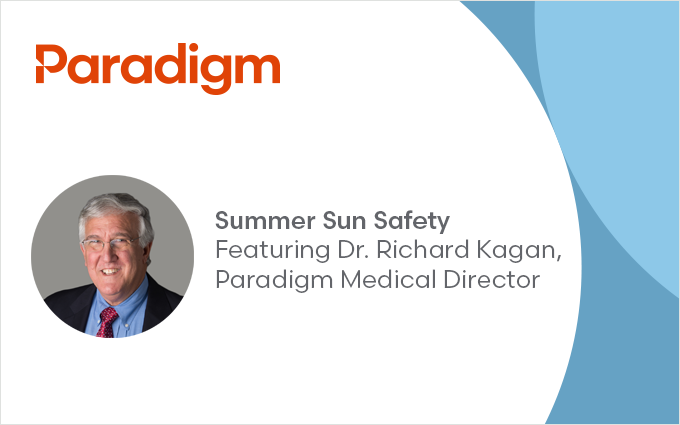08/12/2021

The summer months bring more time in the sun, whether for work or play, but it also increases the risk of burns, sunburns, and other heat-related injuries. With August being Summer Sun Safety Month, Paradigm is raising awareness of the ways that burn prevention impacts the workplace, the home, injured individuals, and their families. Creating a safer and healthier environment at work, home, and in the community not only helps to prevent costly and dangerous sun or burn-related injuries, but it can also benefit people recovering from them.
Recently, we spoke with Richard Kagan, MD, a Paradigm Medical Director and surgeon with extensive experience in treating burn-related injuries. In addition to confirming that summer months do bring an increased risk of burns, Dr. Kagan shared some practical advice that anyone can use to stay safe in the sun and heat. “In most parts of the country, we do find that burns are more prevalent in the summertime, particularly as more people spend time outdoors and engage in fire-related activities,” says Dr. Kagan. “Fortunately, whether we’re talking about work-related burn injuries or those that occur at home, some basic and practical advice can go a long way to improve safety.”
Helping injured workers with burns stay safe in the summer
According to Dr. Kagan, patients recovering from a burn-related injury need to be especially careful during the summer months. “One thing injured workers with a burn should be doing is minimizing sun exposure,” he explains. “For example, burn scars will permanently darken in the sun, particularly for patients with lighter skin, or with burns in areas where the skin is thinner.”
Dr. Kagan recommends wearing clothing to cover the area as much as possible and using sunscreen on any exposed areas. He stresses that even people with burn-related injuries don’t need to expend significant financial resources on sun-protective clothing or high SPF sunscreen. “I’ve never seen any definitive evidence that sun-protective clothing is better than everyday clothing, and the same can be said for sunscreens with an SPF over 30.” Overall, consistency is key for sun protection.
Another risk factor is that burn-injured workers have an increased chance of developing heat intolerance. “Particularly in cases where there is an extensive third-degree burn, surgical treatment results in the loss of sweat glands, so there is a reduced ability to exchange heat through the skin,” he says. For anyone returning to normal activity after sustaining a burn, hydration and heat awareness are both extremely important.
Sun and fire safety at home, work, and in the community
When it comes to burn prevention, Dr. Kagan recommends focusing on the basics. “For sunburns, it doesn’t take long at all for one to develop, and if you start to feel a sunburn, it’s already too late,” he says. “If you’ve been in the pool or in the water and are staying out in the sun, dry off, put on more sunscreen, and cover up as much as possible.” He notes that children and the elderly can be at an increased risk for burn injuries from sun exposure. “At the extremes of age, the very young and the very old, the skin is much thinner and less tolerant of heat.”
During the summer, the sun heating up metal and asphalt can also increase the risk of burns at home and in the workplace. “If you’re a parent, don’t let your child run out barefoot on asphalt without checking it first yourself.” Similarly, any worker should use protective gloves or other skin coverings before touching a metallic surface that has been exposed to the summer sun.
Dr. Kagan also wants to spread awareness of fire safety during the summer months. Many practices for home safety also apply to the workplace. When starting any kind of a controlled fire, from a barbeque to burning yard waste and foliage, he cautions individuals to never use accelerants. “One thing that people should know about gasoline and other accelerants is that it is often the fumes that lead to the initial ignition and flame injuries,” he says. It only takes a very small amount on the skin or an article of clothing to start a fire and cause serious burn injuries.
For anyone who does encounter a fire on themself or another person, Dr. Kagan says the lesson we all learned in grade school still applies: “Stop, drop, and roll. We teach that to kids, but it’s just as appropriate in the workplace.” He continues, “Never wait for somebody to get a fire extinguisher; you need to do something to extinguish the flame immediately.”
Prioritizing worker and family safety
You can learn more about Paradigm’s commitment to helping injured workers and their families achieve the best possible outcomes when complex and catastrophic injuries occur.